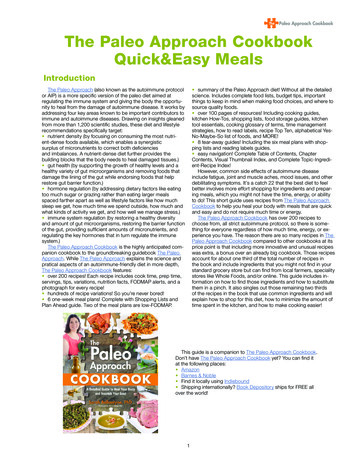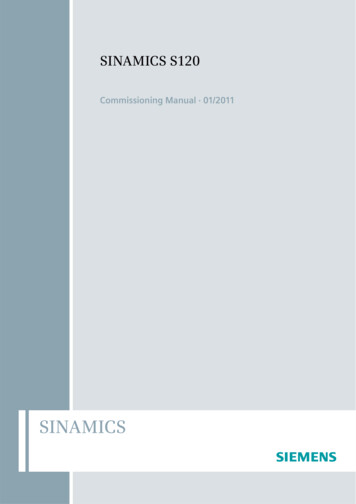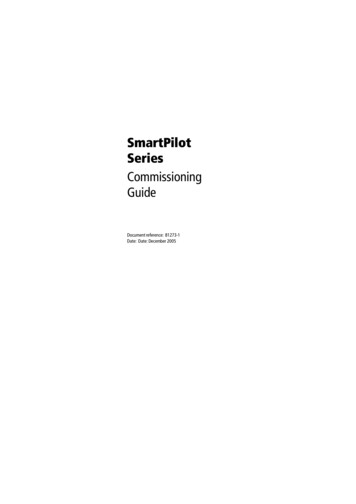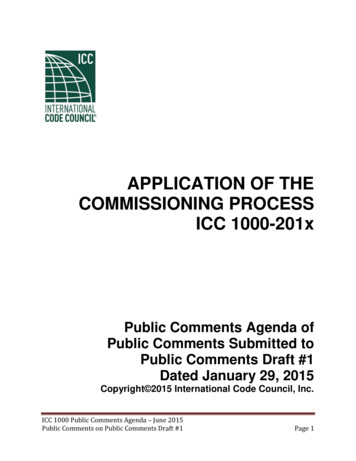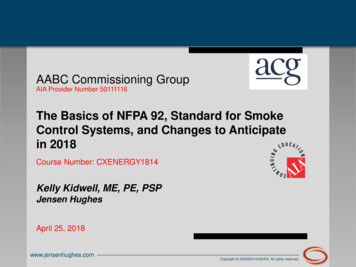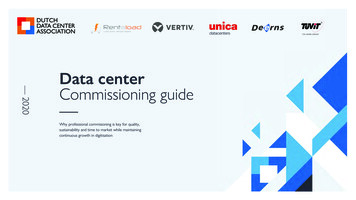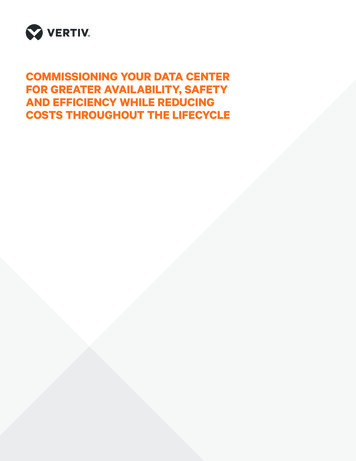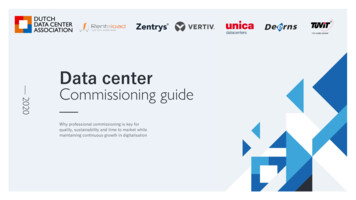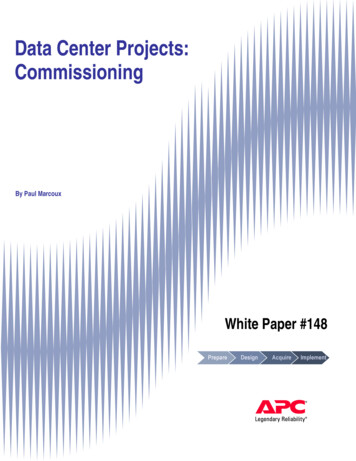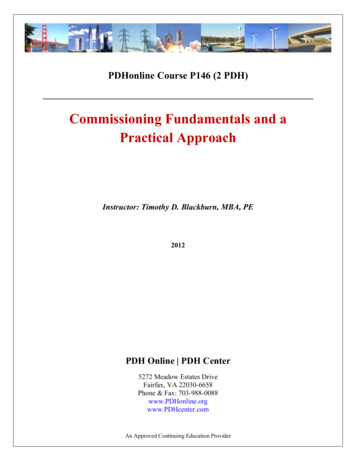
Transcription
PDHonline Course P146 (2 PDH)Commissioning Fundamentals and aPractical ApproachInstructor: Timothy D. Blackburn, MBA, PE2012PDH Online PDH Center5272 Meadow Estates DriveFairfax, VA 22030-6658Phone & Fax: 703-988-0088www.PDHonline.orgwww.PDHcenter.comAn Approved Continuing Education Provider
www.PDHcenter.comPDH Course P146www.PDHonline.orgCommissioning Fundamentals and a Practical ApproachTimothy D. Blackburn, MBA, PEIntroductionHave you ever had something not to work but only discovered long after start-up? Do youhave an uneasy feeling that something might not be installed correctly, but don’t know how toverify? Then try commissioning. Actually, Commissioning is nothing new. What good engineerwould not confirm an installation works? But if commissioning is documented poorly, it isinadequate. If it is done improperly, it is inadequate. Projects routinely have problems. One partof the solution to minimizing project problems is to have a robust and documented Commissioningprocess (assuming the design is robust in the first place). However, we can go to far and judgesuccess by the weight of the paper generated. How can Commissioning be implementedmeaningfully in the real world? This course will attempt to answer this question.The Author has been a leader in the Pharmaceutical industry in the application ofdocumented Commissioning to minimize the regulated paperwork required forValidation/Qualification. He shares his learned experience in this course in the practicalapplication of commissioning, whether in a regulated industry or not. This course is to a generalaudience – see separate material for specific applications to the Pharmaceutical industry.Course ContentWhy Commission?Commissioning is necessary to ensure facilities, equipment, and systems are installed and functionproperly, and are successfully turned over. A documented Commissioning approach offerstraceable verification, and ensures a systematic approach that minimizes commissioningoversights. Effective Commissioning minimizes punchlist items, and improves startup byeliminating problems up-front. Further, certain Commissioning activities may be used to supportdocumentation requirements for regulated industries.Commissioning DefinedCommissioning is a well planned, documented, and managed engineering approach to thestart-up and turnover of facilities, systems, and equipment to the End-User that results in a safe andfunctional environment that meets established design requirements and stakeholder expectations.iThat is, Commissioning verifies what was specified was installed, that it functions properly, and itwas successfully turned over to the user and reasonably ensures the next step verification forregulated industries will be successful.Given this definition, engineers have always commissioned projects to a degree. Forexample, when a new pump is installed, the proper rotation and flow rate is verified. Before it isinstalled, the model number and materials of construction are confirmed. Another example is anHVAC system. The airhandler is confirmed to be leveled and adjusted. The controls are tested.At the end, a test and balance contractor adjusts circuit setters for proper water flowrates, and toPage 1 of 13
www.PDHcenter.comPDH Course P146www.PDHonline.orgadjust dampers for proper airflow. At the end of a project, the operators and maintenance staff aretrained. To have a record of what was installed, as-built drawings and Operations andMaintenance manuals are developed. This is commissioning. All these activities can besummarized in distinct Commissioning categories: Pre-Commissioning activities, Setting-to-Work,Inspections, Testing, and Turnover. (Note: Setting to Work is a potential fourth category, but maybe included under Inspection or Testing as needed.)Pre-CommissioningPre-commissioning activities are Site Acceptance Tests (SAT) and Factory AcceptanceTests (FAT) as well as other similar activities. FAT’s are useful in protecting the business aspectof an investment, by testing the equipment or system at the factory. This allows the system to betested and deficiencies corrected in a manufacturing environment before it arrives on-site withsurprises. The SAT verifies proper equipment and operation on-site. For many projects,especially those with single equipment systems, the SAT may constitute the majority if not all theCommissioning inspection and testing requirements. Further, SAT’s (and FAT’s with caution)may include elements sufficient for aspects of a regulated activity verification. If a FAT isprovided, the SAT could be a reduced regimen. However, be careful in that changes made afterthe FAT in the factory (outside a controlled setting) could affect acceptable outcomes.The following are typical elements of FAT’s/SAT’s, as applicable: Confirm fundamental scope definitions (or Acceptance Criteria) and Specifications Functionality –operate equipment/systems during test Alarms and safeties PLC/Controls thorough checkout/challenge Utilities Maintenance needs Calibration Labeling Training and turnoverSetting-to-WorkSetting-to-work and other regulation and adjustments are needed prior to energizing thesystem or full startup. This could include factory representative start-up, calibration, and otherconsiderations needed before fully operating the equipment and beginning other aspects ofCommissioning.InspectionInspection is the process by which the construction and installation is verified as inaccordance with the detailed design, specified construction standards and materials and anyrelevant legal or regulatory demands related to these areas.ii From the examples above, confirm thepump model number and verifying the airhandler was properly leveled are Inspection activities.Inspection activities generally do not include testing, and often are better handled on formsseparate from testing. (There are exceptions when for succinctness or clarity Inspection items areincluded with Tests.) Inspections are usually visual confirmations. The questions to ask whendeveloping an Inspection checklist are, What needs observing to ensure the equipment is properly installed?Page 2 of 13
www.PDHcenter.com PDH Course P146www.PDHonline.orgWhat needs inspecting to ensure project definition requirements, Acceptance Criteriaand other regulatory issues are met?What inspections are needed to reasonably ensure any subsequent regulatedverification will pass?How will Inspection activities be structured/documented so repetition during anyregulated verification is not required?When these basic questions are answered, commonsense will prevail. There is no need tocreate volumes of documents of marginal value. Yet, documentation must be adequately thorough.The key is to be specific with Inspection line items to ensure documentation is traceable.TestingTesting is the process by which adjustments to, and regulation of, individual systems aredemonstrated as within the required tolerances, system components are demonstrated as deliveringthe required capacity or duty, the functions of the systems are demonstrated as delivering therequired capacity of duty, the functions of the system are demonstrated to be as specified andappropriate.iii Referring again to the commissioning examples earlier in the article, checking thepump’s flow rate and performing test & balance on the HVAC system are all testing activities.Essentially, testing is needed on what was installed to ensure the equipment or system operates asspecified and required. The questions to ask when determining test requirements are, What level of testing is needed to ensure the equipment is properly functioning asspecified? What tests are needed to ensure fundamental design requirements, AcceptanceCriteria, and other regulatory issues are met? What testing is needed to ensure (within reason) any required regulatoryverification will pass? How can the testing be documented/structured so it will not need to be repeatedduring any regulated verification?As with Inspection, when the basic questions are answered, commonsense will prevail. There is noneed to create volumes of useless test documents when the documentation is adequately thorough.As with Inspection, a documented paper trail is recommended to demonstrate (and document) thatequipment and systems are adequately tested.The project is not fully commissioned until Turnover is also completed. Training, Project Closeout(documentation), and Commissioning Documentation are parts of a successful project turnover asfollows:TrainingUnless staff are properly trained, they will be unable to safely and efficiently operate andmaintain the facility, equipment, or system. The commonsense questions to ask before determiningtraining requirements are:1. On which equipment/systems is training required?2. Who needs to be trained?3. What training do they need? (Not everyone needs the same training).4. How must training be recorded?5. What are the required qualifications of the trainer?Page 3 of 13
www.PDHcenter.comPDH Course P146www.PDHonline.orgProject Closeout, DocumentationA project is not complete until all associated documentation is completed and turned overto appropriate individuals. This includes as-built drawings and specifications, Operations andMaintenance Manuals, etc.Commissioning DocumentationGood commissioning is well documented commissioning. Commissioning documentationcould be included in a Commissioning Report for more complex projects. For more complexprojects, a formal Commissioning Plan is helpful to define the commissioning process. But beforewe discuss the elements for a higher documented Commissioning process, let’s ensure we InVESTwisely in Commissioning.InVEST Wisely in CommissioningWhen establishing Commissioning requirements, it is important to remain focused oncommonsense objectives to make the effort meaningful and cost effective. The acrostic InVEST ishelpful in establishing the focus: Integrate: Integrate Commissioning with any other documentation required for aregulated industry if permitted. Don’t automatically do things twice. Integrate alsomeans to include commissioning activities in various vendors’/subcontractors’ scope ofwork, as well as design documents. Verify: Ask: does the Commissioning activity adequately verify the equipment orsystem is what was specified and works as it should? Ensure Regulated Documentation Success: Ask: does the commissioning effortsufficiently ensure any regulated testing or inspection activities will be successful – firsttime? Sensible: Do enough but don’t over do it Traceable: Document it. Remember the saying, “If you don’t document it, you didn’tdo it.”Establishing Commissioning and Documentation RequirementsBefore developing Commissioning Documentation, establish the extent of Commissioningneeded, and design efficient and effective Commissioning around the needs of the project(hopefully as expressed in well-written and thorough project definition documentation. TypicalCommissioning Documents may include the following, depending on project complexity.Overall Commissioning Plan – for large and more complex projects, especially those in regulated environments – this is a masterplan for Commissioning when theapproach needs preplanning and structure. On smaller projects/single equipment,consider relying on Standard Operating Procedure (SOP) requirements rather than aseparate overall Plan.Pre Commissioning: Includes Factory Acceptance Test (FAT), Site Acceptance Test (SAT), and possibly other early inspection/test activities. These are usuallystructured for individual systems, and can be included in or required by CommissioningPlan or Test Plans. These could be stand alone for individual equipment/systems,and/or include essential elements of the Commissioning Test/Inspection PlansPage 4 of 13
www.PDHcenter.com PDH Course P146www.PDHonline.orgCommissioning Test and Inspection Plans: These could be stand alone for individualequipment/systems. These may also supplement areas not covered by FAT’s/SAT’s.Further, self-contained Commissioning Checklists can be used for simple/small work.Don’t create unnecessary volumes of documentation.Commissioning Checklists: For smaller/simpler projects, consider a singleCommissioning Checklist in lieu of more extensive documentation above. Theseoverall checklists may include the following:o Verify item specified was installedo Utility connectiono Functionality checkouto Verify calibration completedo Verify closeout documentation completedo Verify training or orientation completedo CMMS (Computerized Maintenance Management System) entryo Other internal requirementsNote: When sufficient Commissioning direction is provided in specifications or in drawings andfor non-regulated applications, at a minimum consider developing a detailed checklist to ensurecommissioning is completed, and documentation is turned over. This is especially useful in nonregulated applications where a high-level of documentation is not required.The following is a hierarchy diagram of typical commissioning documentation:Page 5 of 13
www.PDHcenter.comPDH Course g Planmay include:-Basic scope of workPreCommissioningActivities(in or directed byCom. Plan)CommissioningTest Plans(in or directed byCom. Plan)-Record Keepingrequirements-Signatory requirements-Reference any definedscope narratives andacceptance criteria-Equipment/System List/Boundaries and ImpactAssessmentFATSetting to Training Verification-Turnover Requirements-Change ManagementapproachNow that we’ve reviewed the typical Commissioning documentation, we need to consider valuesto which we will Commission. When we perform Commissioning, we need to evaluate equipmentand systems to specific quantifiable criteria.SMART Commissioning Acceptance Criteria/RangesAnother helpful acrostic is SMART, which should be considered when assigning values forCommissioning ve
www.PDHonline.org www.PDHcenter.com An Approved Continuing Education Provider. www.PDHcenter.com PDH Course P146 www.PDHonline.org Page 1 of 13 Commissioning Fundamentals and a Practical Approach Timothy D. Blackburn, MBA, PE Introduction Have you ever had something not to work but only discovered long after start-up? Do you .File Size: 262KBPage Count: 14
